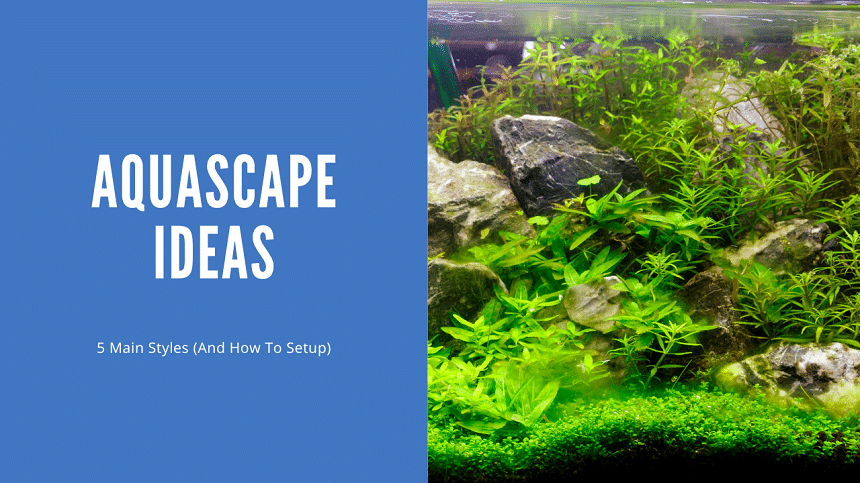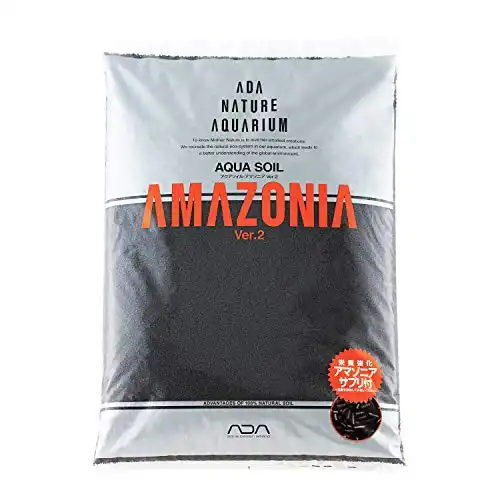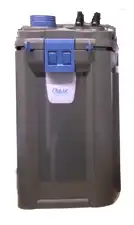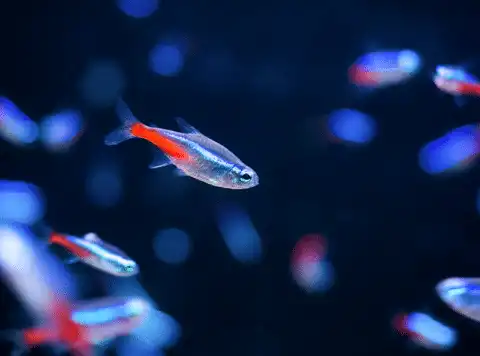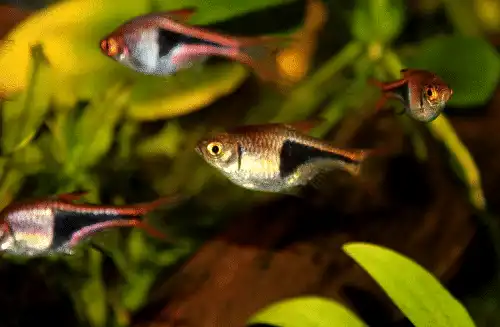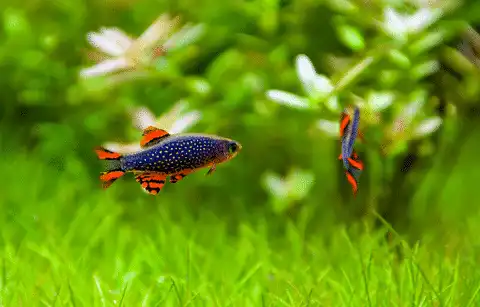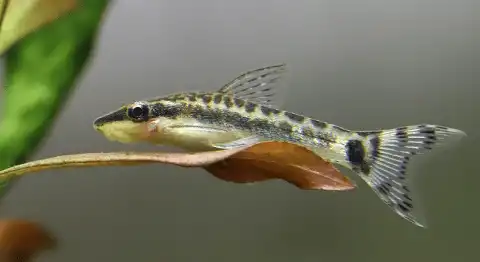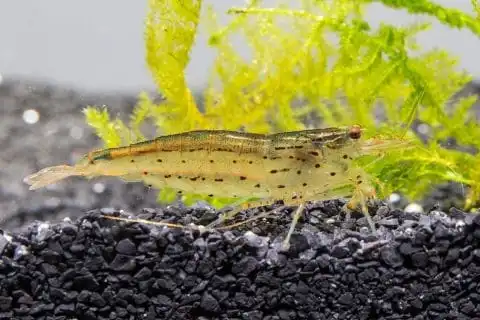Thank you for visiting! By the way… any links on this page that lead to products on Amazon and other stores/partners are affiliate links Aquarium Store Depot earns a commission if you make a purchase.
Aquascaping is a beautiful way to make any freshwater aquarium extraordinary. Think bonsai growing underwater and you’ll get a hint of the true art of aquascaping. The idea is to create visually stunning underwater landscapes using aquatic plants, rocks, wood, and other decorative elements in order to imitate scenes naturally found in nature.
And to do it all in a way that’s aesthetically pleasing to the eye as well as creating a perfectly balanced habitat for fish and other aquatic animals to thrive in. Although it may sound daunting, it’s actually pretty doable once you understand a few of the basic principles and even a complete ‘newbie’ can get started with just a little passion and talent.
Let’s go through an overview and then a few aquascape ideas.
Key Takeaways
- Aquascaping is an underwater living art form that creates stunning underwater landscape
- There are several popular styles that are used in aquascaping with Nature Aquariums being the more predominant
- They involved aquascaping rocks, driftwood, and aquatic plants
- They often will require CO2 injection to enhance growth
How to Get Started?
If you’re completely new to aquascaping, the very first thing you’ll need to do is decide on what type of critter are you looking to keep, or if this is going to be a one hundred percent horticulturist endeavor?
And I say critter because with all the options of aquascaping available, it’s possible to keep anything from fish to small shrimp and even frogs. So the more you understand what type of aquatic creatures you’re trying to make happy, the easier it will be to try and replicate their natural habitat, or at least somewhere they’d enjoy living.
For example, if I wanted to have a beautiful nature aquariums with small freshwater shrimp and a few tetras, I would opt for an Iwagumi style set up. Or for fish like Cichlids, I would use the Biotope Style.
But if this is simply for your enjoyment and have no plans on keeping any specific aquatic pets, then there’s a whole world for you to consider.
Understanding what’s going to live in your newly created natural habitat, or not, can help narrow down your focus and shorten the learning curve considerably.
Considerations
- What will live in the tank
- How big is your tank
- How much are you willing to spend
- How much time do you have for maintenance
- Your personal aesthetics
What’s Next?
Now that you have an idea of what will live in your freshwater aquarium and a taste of what’s involved, it’s time to see what style you would want to recreate in your own tank.
This is aquascaping, simply landscaping under water in a confined space. So the best place to see what you might like is to look at some regular landscaping pictures.
Type in something like ‘beautiful landscapes’ into your search engine and click ‘images’. You’ll be presented with thousands of images, all of them potential aquascapes for you to clone and experiment with.
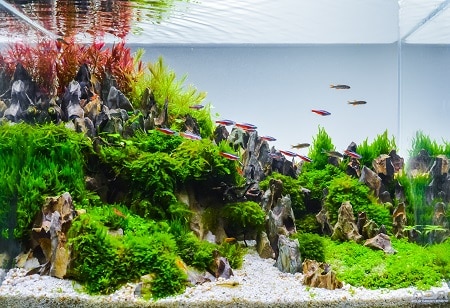
Choose a few images that really inspire you, and notice what they all have in common. Are they all sprawling grass fields, or forest covered mountains?
This is what you feel is beautiful or have some sort of connection with, and it’s also what you should be working towards in your own aquascape ideas. After all, it’s you that needs to see it everyday!
Once you have an idea of what you connect with, explore the different styles of aquascaping to see which style most resembles your personal choices. It’ll be easier to understand one style’s complexities than trying to learn the whole hobby at one go.
Just like in ‘real’ landscaping, there are a lot of styles of aquascaping and you just need to figure out which aquascape ideas float your boat.
Once you narrow your focus on which style resonates with you, then you can go deeper into researching everything that goes into that particular aquascape.
Here Are A Few Of The Main Aquarium Styles
Nature Aquarium Styles
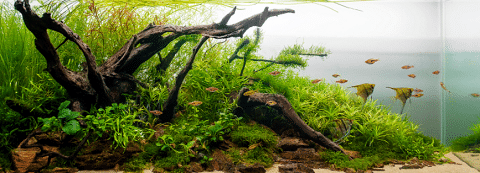
Nature aquariums are definitely one of the most popular aquascaping ideas and was originally developed by Takashi Amano from Japan. Takashi took what he knew, and incorporated the lush high mountain peaks of Japan into his art using aquascaping rocks, mosses and other aquatic plants and hardscapes.
His style is one in tune with nature and wanting to bring the beauty of large landscapes into a small underwater space. Everything is as natural looking as possible and well balanced for a sense of serenity when looking at one of his creations.
Dutch Aquarium Style
Originating in the Netherlands, Dutch aquascaping is characterized as vibrant and full of color and variety. This planted aquarium style focuses on aquatic plants rather than other materials.

More of an underwater flower garden, Dutch aquarium aquascapes contain patches of a wide variety of plant species that are arranged neat rows and patterns. The densely planted aquariums are well manicured and are reminiscent of the old traditional gardens of the Netherlands.
Iwagumi Style
The Iwagumi aquascape originated with the same man who started the Nature Aquarium style, Takashi Amano. Only this time, he went for a super minimalist appearance creating sprawling low landscapes that bring the eye to a few key focal points, usually strategically placed stones all having their own importance in the overall balance of the Iwagumi aquascape.

Short aquatic mosses help create a sense of grandeur of the jutting rocks while giving the Iwagumi aquascape a life form all its own.
Biotope Style
Biotope aquascapes are great when you have a certain species of aquarium fish you want to keep and pamper as best you can. The aquascapes are literal miniature ecologically correct environments that replicate the fish’s natural habit down to the last detail.
These can include what you’d naturally find in rivers, swamps, or other aquatic terrains. Done right, your aquarium fish should never realize they are in a fish tank and not in their natural habitat.
Paludarium Style
One of the more difficult aquascaping styles to pull off, these aquascaping ideas require three key components; water, land, and a canopy portion. That means your tank will never be completely filled with water which is perfect if you want to keep a small frog or two. You can see a world class Paludarium below from Green Aqua’s YouTube channel.
They include terrestrial plants and aquatic plants, making them a true biozone. And although they may be a bit more complicated, they do open up the possibilities when it comes to what you can keep in your tanks.
Setting Up Your Tank
When it comes to your aquarium, you really want to go with the largest freshwater aquarium you can afford or fit in your space. A twenty gallon fish tank and a few plants is a great start, but a hundred gallons is even better. Only go with small aquariums if you’re working with a really tight budget.
You’ll also want to use a rimless tank that doesn’t have any braces or other materials that take away from your aquascape. You want a tank that is pure glass and a solid stand.
UNS offers a quality rimless aquarium at a great price. One of the big pure rimless aquarium brands you can purchase today!
As far as a stand, it’s a good idea to get a cabinet type. You’ll need a few tools and possibly a CO2 tank for your aquascape, and it makes it easier to hide all your equipment so everything looks as clean and professional as possible.
Personally, I like a very dark colored cabinet stand so when the aquascaping lights are on, you don’t even notice what’s underneath the aquarium.
Substrates
Substrates are extremely important in a planted tank due to all of the live plants you’ll be working with. It’s needs to be both fertile enough to sustain your aquatic plants, and hardy enough for the plants to root in and support rooting plant growth.
If you’re only working with carpeting plants like mosses, then your plant substrate isn’t as important. But even small plants need something to grow in.
And just like the live plants that grow in your yard, many aquatic plants pull nutrients from the soil using their roots. That means your plant substrate will need to include these nutrients and possibly be easy enough to change or add more when they’re depleted.
The Best Planted Tank Substrate
The world's standard in active substrates for planted tanks. Created by brand that founded modern aquascaping
Walstad Method
The best method for achieving a well balanced planted tank is the Walstad Method.
This method of growing aquatic plants in aquascapes is named after the woman named Diana Walstad who literally wrote the book on it, (see: ‘ECOLOGY of the PLANTED AQUARIUM – A Practical Manual and Scientific Treatise for the Home Aquarist’).
When done correctly, this method provides all the nutrients your aquatic plants will need and you won’t need to change the soil or add any additional nutrients. You can see an example of this setup from Ceyhun Derindere Aquatics’ YouTube Channel.
This is because the plants will quickly create a chemically balanced biological ecosystem within your tank and break down any fish refuse to be used by your plants as fertilizer.
Once established, you shouldn’t even need to use a filtration system for your tank as the plant life and biological ecosystem created naturally does all the work for you.
All you need to do is get some quality potting soil that you can find at any garden center. Just make sure there are no added chemical fertilizers!
Add at least one inch of the soil in the bottom of your tank. Then add a thin layer of sand, or 2 inches of medium fine gravel so the soil can always breathe. That’s it!
The only thing you need to be aware of is you must give your fish tank a minimum of two months to stabilize and be ready for your fish.
Sand and Gravel
Both sand and gravel make great substrates depending on the aquascaping plants you’re growing. Both come in all sorts of sizes and colors and are easy enough to source.
Just be sure that your aquatic plants match they type and size you’re looking to use. Tall plants find it hard to root in small particle sized sand whereas mosses will have problems rooting in large gravel substrates.
And also take your fish into account. Don’t use substrates with sharp edges if you’re going to include catfish or other bottom dwellers.
Hardscape Materials
Hardscape materials will either make or break your entire design. Everything about them is important, their size, color, material, everything. After all, these are the focal points of your aquascape and should be added after you’ve finished adding your substrate.
Rocks
Although you may think rocks are pretty boring, there are actually a massive amount of different kinds of rocks. And each one you place in your tank will have an effect on the overall experience of your aquascape. So take your time finding that perfect aquascaping rock!
Editor's Choice
Ohko is the premier aquascaping rock today. Granite based with amazing shapes and selection
Obviously what look you’re going for will determine a lot as far as choosing your rocks. For a Nature Aquascape you’ll usually want dark colored rocks with interesting designs that can look like mountain peaks or far away mountains.
If you’ll be adding rocks to a Dutch style tank, then you should be looking for colors that play off the types of plants you’ll be using. Or sizes that won’t overpower the rest of the scene.
Some great rock types to start with are Dragon stone, Lava rock, Ryuoh or Seiryu, Ohko and Elephant Skin rocks are all used in aquascaping.
Which one you choose to use is going to depend on how you want your finished aquascaping design to look.
Driftwood
I absolutely love the look of ragged, aged driftwood in a tank. Driftwood has so much character, and the colors are perfect for a natural tank. But you can use other types of wood like petrified woods,
Best used in Nature, Biotope and Paludarium Styles of aquascaping, driftwood can be used as a central focal point or for layering to bring depth of field to a scene.
Editor's Choice
Manzanita offers it all. Great shape, low tannins, quick to water log and reasonably priced. It's the ultimate driftwood!
Coupled with plants like Java Moss or Anubias Barteri, your wood becomes a living organism that looks amazing with a few freshwater invertebrates grazing on them.
Filtration
Great filtration is a must for any aquarium, and even more so when you include soil, wood and plant life into the mix. Rotting plant material decomposes over time and add a lot of different elements to your water that must be filtrated out.
And that’s not to mention the addition of fish to your tank. Even small fish species produce waste that needs to be filtered out in order to keep your water well balanced.
The best and most natural way of handling all this when you can is to use the Walstad Method I described above. Then instead of waste, you have fertilizer.
But if that isn’t possible, then you’ll need to think about the best sort of filtration system yo use for your specific aquascape. Usually, some sort of external hang-on back (HOB) filter or canister filter.
Canister filters are the best you can get. They can be hidden underneath your tank, and you can use almost any type of filtration medium you can find. They come in all sizes and can handle even the biggest water volume. The only problem is they’re also the most expensive type of filter system.
The Pro's Choice
The top choice among professional aquascapers. German engineering and equipped with an intregrated heater.
A less expensive type is the HOB filter. These filters simply hang on the back of your tank and are simple in terms of how they’re used. So they can be a solid starting point for a new aquarist.
But they also have many drawbacks. The first being that they hand on your tank. For aquascaping, this is definitely not ideal. Furthermore these filters can’t hold nearly the amount of filtration media that canisters can, nor are they as quit when running.
They are also not meant for larger tanks as they aren’t all that powerful.
So if you have the funds, I highly suggest just going for the canister filtration system.
Lighting
Since aquascaping relies heavily on plants to complete their overall scene, having the correct lighting for plants to photosynthesize and fish to thrive is going to matter a lot.
Unlike other types of aquarium lighting, we are looking for lighting options that are specifically designed for growing aquatic plants. This is one area where the needs of your fish take a back seat.
In a traditional aquarium set up, fluorescent light bulbs would be fine for most plants and fish. But they aren’t well suited for aquascaping plants and should be your last choice.
The very best lights for your aquascapes would be bulbs that mimic natural daylight. And they need to be strong enough to reach the depths of your tank while not creating a lot of heat and effecting the water temperature.
LEDs are the perfect choice for aquascaping. They can do all of that and more. In fact, you can do all sorts of cool things with LED. They can be easily timed when they come on and off.
Current USA's offering into aquascaping is an incredible value. Spectrum, spread, easy to program and great PAR output.
You can dim your lighting, or even dim or brighten certain areas of your tank all with the same light source. You can even add different colors or light spectrums to the mix.
There really isn’t much you can’t do with LEDs today. And they are much more energy efficient than other types of grow lights. So over time they can end up saving you money.
Plants
Obviously, plants are going to play a major role in any aquascape. Your plant choices will ultimately depend on the overall aesthetic you’ve chosen and the type of aquascape style you want to achieve.
You’ll also need to take into consideration the individual requirements of each plant. It’s best if you have similar species of plants that require the same lighting, temperatures and water hardness so it’s easier to maintain your tank. And slower growing plants will need less pruning.
There are actually four groups of plants you need to consider when planning your aquascape based on their size and where they will be placed in your setup. The idea is to vary the heights of your plants to give your tank an overall feeling of depth to the scene.
Background – Background plants will usually be the largest plants in your aquarium. The ones I’ve listed here are the easiest to source and grow to about 12 inches (30 cm) or more. They do come in a variety of leaf shapes and sizes, but the only color variations are greens and reds.
- Vallisneria
- Pogostemon stellatus ‘octopus’
- Water sprite
- Amazon sword
- Bacopa caroliniana
- Pearl weed
- Alternanthera reineckii var. ‘roseafolia’
- Tiger lotus
Midground – Your Midground plants are next. They only grow to a medium height of about six inches tall and should be used somewhere in the middle of your tank in front of your background plants.
- Java fern
- Anubias species
- Cryptocoryne species
- Alternanthera reineckii
- Red dwarf Hygrophila
- Blyxa short leaf – Blyxa novoguineensis
- Chain Sword
- Dwarf Cardinal plant – Lobelia cardinalis
- Downoi – Pogostemon helferi
- Basil Leaf – Limnophila rugosa
- Water Hyssop – Bacopa caroliniana
Foreground – The area closest to you as your viewing your tank, most aquascaped foregrounds will include some of your smallest plants so you have a clear vision of the entire scene.
Some species are also called carpeting plants, and many types of mosses are incorporated here giving your aquascape a lawn effect, or rolling hills like in the Iwagumi style of aquascaping.
- Staurogyne repens (S. repens)
- anubias nana petite
- dwarf hairgrass (Eleocharis acicularis)
- Micro sword (Lilaeopsis brasiliensis)
- dwarf chain sword or pygmy chain sword (Helanthium tenellum)
- Hydrocotyle tripartite
Carpeting Plants
- Dwarf baby tears (Hemianthus callitrichoides ‘Cuba’)
- Monte carlo (Micranthemum tweediei)
- Mini pennywort (Hydrocotyle tripartita “Mini”)
- Creeping Staurogyne (Staurogyne repens)
- Vietnam Ambulia (Limnophila sp. “Vietnam” )
Floating – Floating plants are helpful in low to medium light conditions as they can provide cover and can be arranged in ways to shed shade on the areas of your tank that need less light.
And since these types of plants do not grow in the substrate, they can be added or taken away easily. Plus, the species with roots can add a lot of drama to the overall feel of an aquascape as the plant roots hand down into the scene.
- Duckweed (Lemna minor)
- Hornwort (Ceratophyllum demersum)
- Amazon Frogbit (Limnobium laevigatum)
- Dwarf Water Lettuce (Pistia stratiotes)
- Water Spangles (Salvinia minima)
- Mosquito Fern (Azolla filiculoides)
- Pennywort (Centella asiatica)
Fish Species
Your fish should be the last thing that’s added to your aquarium. Your aquascape will need some time to take hold and after you first finish, you will probably want to make some adjustments which means arranging aquatic plants which your fish won’t take kindly to.
And it also takes some time for the water to become more stable and establish a healthy ecosystem. This can take as long as two months, so be patient.
Give your aquascape the chance to cycle through and the plants to take root. then when you introduce your fish, they’ll feel right at home with no disturbances.
As far as which fish to keep, remember, the aquascape is the focus, not the fish. They are just the decoration. So you want fewer and smaller fish than you would otherwise.
This also helps to give the aquascape more of a sense of largeness or openness. A big fish would just look really out of place!
Just try to match your fishes requirements with that of your plants. If all of your plants need strong light or warm water, make sure the plant safe fish you include can tolerate these same conditions.
Small schooling fish like Neon Tetras are perfect for these types of tanks since they are easy to care for, don’t pull up plants and can live in all types of freshwater aquariums.
Use Promo Code ASDFLIPPROMO
One of the most popular freshwater community schooling fish available in the aquarium trade. Great neon blue colors!
These fish only grow to an inch and a half and are inexpensive and easy to source. There are many different tetras and any of these colorful fish would do well in an aquascaped environment.
Harlequin Rasboras are another great choice reaching less than an inch and a half full grown, they are easy to source and are very inexpensive. They’re easy to keep, school well in groups and don’t disturb your plants. Overall a great choice.
A peaceful schooling fish. An ideal community fish. A great beginner fish
Celestial Pearl Danios, or Galaxy Rasboras are beautifully colored fish and work well in Natural or Iwagumi tanks where there isn’t much color. These easy to care for fish are still a bit rare and much more expensive than the Tetras or Rasboras, but they are worth the cost.
A great-looking danio fish. Males are more colorful than females. A midway dwelling fish
The best part is these fish naturally live in heavily planted ponds and grow to less than two inches, so an aquascaped tank would be the best option to keep these fish healthy and happy.
The Spotted Blue-eye is another easy choice. Colorful and timid, this fish’s natural habitat is heavily planted shallow pools. They rarely grow to over an inch and a half and add some pizazz to any planted tank.
The Neon Blue Tux Guppy (Poecilia reticulata) is another peaceful fish that looks great in aquascapes. You should keep at least six as they like to school, and you can keep up to 20 or 30 if your tank is large enough. This brilliant blue tailed fish grows to be about around 1.5 inches and is easy to manage and find at most fish stores.
Another fish you should include is a Otocinclus Catfish. These are small busy fish and should be kept in groups of three or more. These guys will help you keep your tank clean by eating most forms of algae which is always a bit of a problem when it comes to heavily planted tanks. If you have a larger aquarium, keep five to ten to help out with your tank maintenance.
A small algae-eating fish. Also great with freshwater shrimp.
Shrimp are another great way to combat algae growth and are very interesting to watch and even breed. Neocaridina Shrimp are probably the best ones to start off with. They are stunningly colored and come in reds, blues, yellows, and greens.
They’re also easy to find and care for and if your tank is properly maintained, they’ll breed with no problems.
You can also try Caridina multidentata, or ‘Amano Shrimp‘ respectfully named after Takashi Amano after he made these crustaceans ‘famous’ using them as a way to keep down algae in his creations, especially in his Iwagumi Style aquascapes.
Best For Planted Tanks!
When it comes to keeping a healthy planted aquarium, Amano Shrimp are the best. These hard-working crustaceans will dutifully wipe your plants and rockwork clean of algae. Their appetite for different types of algae that can't be matched by other shrimp breeds!
These little translucent shrimp will eat almost any type of algae and are cheap and easy to find at most pet shops.
Maintenance
Since you’re primarily keeping an underwater garden, it’s smart to focus on your aquatic plants as much as possible since your plants will end up helping you maintain you aquarium once they’re established and happy. Yes, plants can be happy too!
The perfect aquascape should rely on the miniature ecological environment in the tank to take care of most issues. Your plants should be absorbing the carbon dioxide from your fish, and the fish should be breathing the oxygen from the plants.
Any fish waste should be fertilizer for the aquatic plants and food for your catfish and shrimp.
Think of how nature works and that’s what you should be trying to replicate inside your aquarium. The closer you get, the less maintenance you’ll need to do.
Daily Tasks
Do daily inspections of your plants, fish and anything living in the tank. notice if your fish are loosing their colors, or seem lethargic.
See that your plants are steadily growing and there are no brown spots or dying leaves.
Check for algae growth and ensure your filters and lights are all working correctly.
Water changes are the most important thing you can do to keep your aquascapes pristine. And it’s far better to do a 10% or 20% daily water change that a 50% change once a week.
If you’re unable to stick to a regime like this, do the best you can. Even every other day or every two days is better than weekly changes. Just be sure the water you’re adding is close to the same temperature of your tank’s water so as not to shock your pets inside.
Weekly Tasks
Clean the aquarium glass inside and outside the aquarium. Even if it looks clean, small algae spores may begin to collect and it’s best to never give them a foot hold on your tank.
Check your plants and trim any ones that are not growing the way you want. Really look at them and be sure their leaves are clean and smooth and nothing is eating them.
You may need to vacuum your substrate if possible from time to time. But you need to be very careful as not to bring up any soil under the substrate if you’re using the Walstad method for your aquatic plants.
Test you water’s pH range and carbon dioxide levels to make sure your plants and fish are happy and safe.
And if you haven’t done daily water changes, you must do at least weekly changes or you’ll run into problems! If done weekly, you need to do at least a 50% change. Just make sure the water temperature stays stable when making such a large change.
Wrapping Up!
Getting started aquascaping is as easy or complex as you want it to be. And the diversity of the hobby is enough for anyone to keep busy for a life time. All you need is a bit of imagination, a few bucks and an aquarium. After that, the rest is up to you.
- About the Author
- Latest Posts
I’m thrilled that you found Aquarium Store Depot! Here you’ll find information on fish, aquariums, and all things aquatics related. I’m a hobbyist (being doing this since I was 11) and here to help other hobbyists thrive with their aquariums! I adhere to a high quality Editorial Process and Review products with real life field usage and practical analysis.

